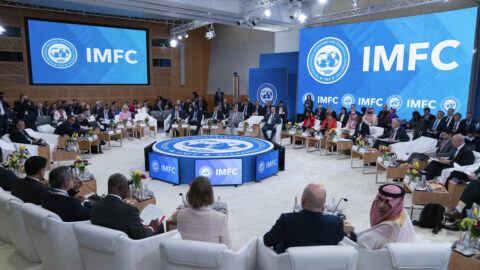The International Monetary Fund/World Bank Group Spring Meetings 2025 took place in Washington, D.C., and I participated on behalf of Erste Asset Management. Thanks to a wide range of high-ranking representatives from various emerging market countries’ governments and central banks, financial institutions, think tanks and academics, the meetings offer highly valuable insights into current and upcoming global challenges in both economics and politics.
Among all the diverse subjects which were covered throughout the panel discussions, interviews and meetings, the following topics have represented the most outstanding and shared global concerns among the conference’s participants.
US tariff policy as a substantial shock to global economy
The new US administration’s announcement of a broad 10% tariff on all countries and an even higher rate on 57 states, with China facing the highest, effectively 145% after the multiple hikes, had caught the markets off guard. Given the subsequent market turmoil, the US government rescinded its decision and reduced the tariff rate for all countries to 10% for 90 days (further extensions possible for some countries conditional on signs of good faith during negotiations) except China, which responded with a counter tariff of 125% against all US imports. This policy inconsistency which troubles many market participants, has further increased the already elevated level of uncertainty.
Recent statements by US government officials indicate that negotiations on tariffs are ongoing with multiple countries. On the other hand, there are conflicting reports on whether talks between the USA and China have even started yet. The US administration regards the mutual tariffs in their current form as unsustainable as it does not aim to decouple from China. However, the US side emphasises that non-tariff barriers and military concerns must be addressed, too. An important part of a deal between the USA and any country will be what the latter can offer to buy from US companies to reduce the US trade deficit.
The tariffs are tantamount to a large tax increase for US consumers and their effect on both the US and global economy is being amplified by the sentiment shock they caused and the potential of a financial sector disruption. Nevertheless, a US economic recession, which could result in millions of people losing their jobs, corporate profits falling by 10-15% and GDP shrinking by more than 1%, appears to be at least half a year away with jobs being still created and the economy appearing relatively healthy. In case that a recession can be avoided, profit margins and household savings would decline significantly whilst inflation would likely remain elevated, i.e., resulting in a stagflation scenario.
Political pressure on Fed increases
In this context, the political pressure on the Fed to cut the policy rates is increasing whilst it tries to protect its independence, which is crucial to uphold its credibility and significantly helps rein in inflation. The Fed is likely to continue to focus on unemployment as the key factor whilst economic growth is not a priority. One of the key measures the US government plans to take to support the economy is to reduce financial regulations whilst lowering the budget deficit in terms of GDP by one percentage point per year.
Besides China’s neighbouring countries which are now courted by Beijing, European countries have gained considerable leverage over China which they can use to force both economic and political concessions from the Chinese administration. Furthermore, European assets such as the Euro, Swiss Franc and sovereign bonds are experiencing a renaissance as safe havens with the exposure to US assets being reduced globally.
Outlook on emerging market economies
Argentina has been one of the investor favourites for the last few months. Thanks to the far-reaching measures taken by the new government under President Milei, the annual inflation rate has come down from its peak of 289 percent in April 2024 to 56 percent in March 2025 and the economy has emerged from a recession in the last quarter of 2024. Upholding the fiscal restraint will be crucial to maintaining the economic successes. Winning the midterm elections later this year, with polls indicating a close race, would give the government a boost to implement further reforms. There is also foreign support for President Milei’s policies. If the Argentinian administration were to be hit by an external shock which could harm its reforms, the US government signalled that it could step in to help Argentina with a credit line via the Exchange Stabilization Fund.
Although the Brazilian inflation rate has come down from its highs in 2022, it has proven to be stickier than that of comparable countries. Also, for the last four years, Brazil’s economy has exceeded the projected growth rate and appears to have grown beyond its potential. This is why the country’s central bank places a large emphasis on the management of inflation expectations and has also decoupled from its peers by hiking the policy interest rate. Given that general elections are due next year, fiscal spending is likely to pick up which will be reflected in the central bank’s tight stance.
Compared to all other countries, Mexico, along with Canada, receives preferential treatment by the USA regarding trade policies, which could help Mexico to even increase its US market share despite the tariffs. Currently, around 50% of Mexico’s exports to the USA are exempt from duties under the USMCA and another 40% are subject to very low duties under the most-favoured nation rule, leaving only 10% exposed to a heightened tariff rate. A trend towards nearshoring would also be beneficial for Mexico which tries to contain the reexporting of subsidised Chinese goods by third country firms.
In South Africa, the government is poised to make its third attempt of getting the budget plan through parliament after the planned increase in the value-added tax rate was scrapped, thereby also saving the coalition which consists of ten parties. The National Development Plan 2030, which envisions an improved infrastructure and thereby an increase in economic activity, can only be accomplished if public and private investments increase. Lower energy prices help to reduce the inflationary pressure, giving more room for the central bank to further decrease the monetary policy rate.
The government of Poland has to curb its spending to avoid the strict rules imposed by the EU if a member country’s fiscal deficit exceeds 3% of its GDP. Given the upcoming presidential elections, being compliant with this limit until 2028 as previously pledged will be difficult, as winning the ballot is crucial for the government to implement its legislative goals. The European push to rearm is further straining the budget, despite a four-year annual exemption for military spending of 1.5% of GDP.
No immediate peace in sight in Ukraine
The war between Ukraine and Russia is still raging, with the latter advancing at great humanitarian cost and no immediate peace in sight. Some of the biggest hurdles to settling the conflict are as follows. Russia demands that Ukraine cedes around one fifth of its territory, demilitarises, makes changes to its laws (e.g., official language) and abandons its aspiration to become a NATO member. Furthermore, questions regarding the sanctions imposed on Russia and the frozen financial assets remain unanswered. On the other hand, Ukraine disagrees with these demands and expects reparations. Eventually, both sides will have to find a solution by negotiating as currently neither side can make a decisive blow on the battle ground.
A trade deal between India and the USA could be within reach as indicated by US officials, keeping in mind that an agreement in principle can be achieved quickly but a full treaty can take months to be written out in full. With the inflation rate reaching the lows of pre-COVID-19 times, the Indian central bank is likely to continue to cut the repo rate in 25 basis points steps after the first two cuts of this year. The armed conflict in the Kashmir region has had no significant impact on Indian assets but any further escalation could change that quickly.
Given the US protectionism, Chinese producers are now under pressure to find additional markets for their goods in order to substitute the reduction in demand from the USA. The extent to which the trade between the two countries is now strained in real terms is reflected in Chinese container shipping volumes which are down by a quarter compared to last year. Well aware of the fact that a decoupling would hurt the USA substantially, the Chinese administration has a strong position during negotiations and can leverage its role as the largest trade partner of most countries worldwide.
Legal disclaimer
This document is an advertisement. Unless indicated otherwise, source: Erste Asset Management GmbH. The language of communication of the sales offices is German and the languages of communication of the Management Company also include English.
The prospectus for UCITS funds (including any amendments) is prepared and published in accordance with the provisions of the InvFG 2011 as amended. Information for Investors pursuant to § 21 AIFMG is prepared for the alternative investment funds (AIF) administered by Erste Asset Management GmbH pursuant to the provisions of the AIFMG in conjunction with the InvFG 2011.
The currently valid versions of the prospectus, the Information for Investors pursuant to § 21 AIFMG, and the key information document can be found on the website www.erste-am.com under “Mandatory publications” and can be obtained free of charge by interested investors at the offices of the Management Company and at the offices of the depositary bank. The exact date of the most recent publication of the prospectus, the languages in which the fund prospectus or the Information for Investors pursuant to Art 21 AIFMG and the key information document are available, and any other locations where the documents can be obtained are indicated on the website www.erste-am.com. A summary of the investor rights is available in German and English on the website www.erste-am.com/investor-rights and can also be obtained from the Management Company.
The Management Company can decide to suspend the provisions it has taken for the sale of unit certificates in other countries in accordance with the regulatory requirements.
Note: You are about to purchase a product that may be difficult to understand. We recommend that you read the indicated fund documents before making an investment decision. In addition to the locations listed above, you can obtain these documents free of charge at the offices of the referring Sparkassen bank and the offices of Erste Bank der oesterreichischen Sparkassen AG. You can also access these documents electronically at www.erste-am.com.
Our analyses and conclusions are general in nature and do not take into account the individual characteristics of our investors in terms of earnings, taxation, experience and knowledge, investment objective, financial position, capacity for loss, and risk tolerance. Past performance is not a reliable indicator of the future performance of a fund.
Please note: Investments in securities entail risks in addition to the opportunities presented here. The value of units and their earnings can rise and fall. Changes in exchange rates can also have a positive or negative effect on the value of an investment. For this reason, you may receive less than your originally invested amount when you redeem your units. Persons who are interested in purchasing units in investment funds are advised to read the current fund prospectus(es) and the Information for Investors pursuant to § 21 AIFMG, especially the risk notices they contain, before making an investment decision. If the fund currency is different than the investor’s home currency, changes in the relevant exchange rate can positively or negatively influence the value of the investment and the amount of the costs associated with the fund in the home currency.
We are not permitted to directly or indirectly offer, sell, transfer, or deliver this financial product to natural or legal persons whose place of residence or domicile is located in a country where this is legally prohibited. In this case, we may not provide any product information, either.
Please consult the corresponding information in the fund prospectus and the Information for Investors pursuant to § 21 AIFMG for restrictions on the sale of the fund to American or Russian citizens.
It is expressly noted that this communication does not provide any investment recommendations, but only expresses our current market assessment. Thus, this communication is not a substitute for investment advice.
This document does not represent a sales activity of the Management Company and therefore may not be construed as an offer for the purchase or sale of financial or investment instruments.
Erste Asset Management GmbH is affiliated with the Erste Bank and austrian Sparkassen banks.
Please also read the “Information about us and our securities services” published by your bank.



